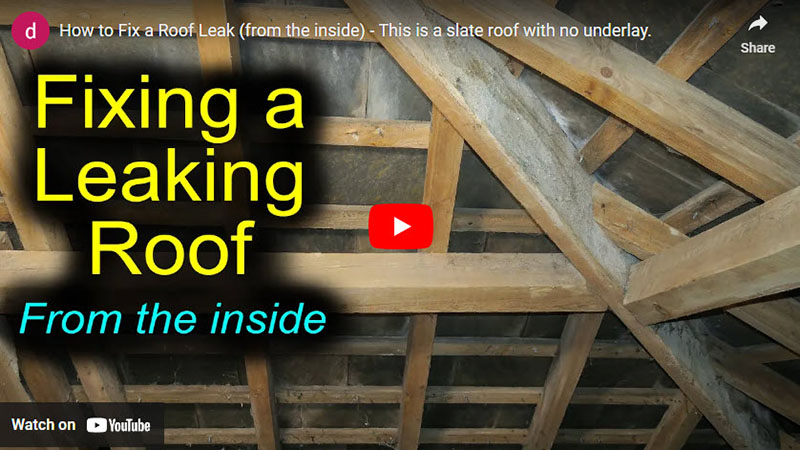How to Fix a Roof Leak from the Inside (Without Climbing the Roof)
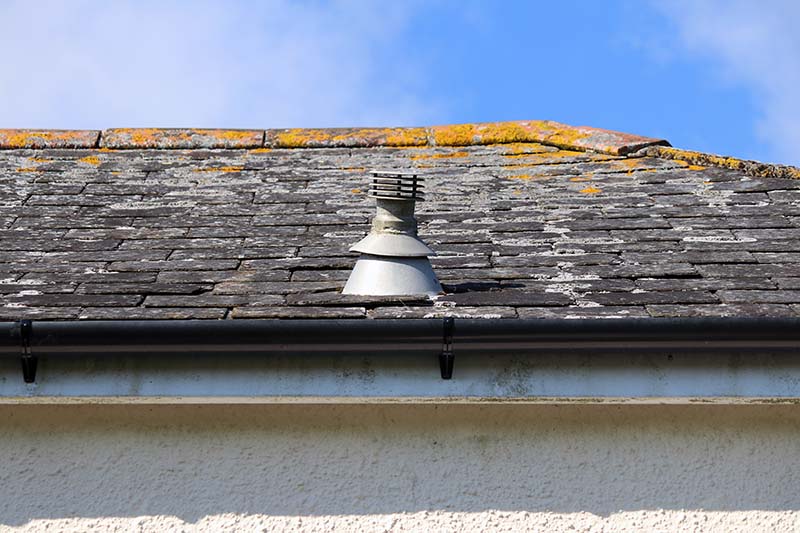
If you’ve discovered a roof leak but want to avoid the risks of climbing onto the roof, you’re in luck. Fixing a roof leak from the inside, such as from your attic or loft, is often a safer and simpler option. Roof work can be dangerous, and even a fall from a single-story building can cause serious injuries. That’s why this interior method could be a great solution in many cases.
When Is an Interior Roof Leak Repair Suitable?
This approach works best if the leak is caused by:
- A small crack in a roof tile or slate.
- A minor hole.
- Wind-driven rain forcing its way in.
If your issue is just a hairline crack or small hole, you can often stop the leak from the inside using this method, (explained below). However, if the damage is more extensive, like a large hole. You may still be able to apply a temporary fix from the attic by placing a piece of slate, tile, or waterproof material over the gap.
Long-Term vs. Temporary Roof Leak Repairs
While an interior fix can stop the water intrusion with cracks, small holes and windblown rain. It’s important to understand that this is not a permanent solution for missing slates or larger holes. Replacing a cracked roof tile or slate from the outside, is always the most reliable and durable repair method. But if the weather is bad, or you need an emergency fix before calling a professional roofer, this method may be a great stop-gap for larger holes. And can provide a permanent fix for the smaller issues.
Topics:
Detail:
- Where is the Leak?
- How to Find It?
- What’s Caused it?
- When is it Not a Roof Leak:
- Underlay:
- How to Fix a Roof Leak?
- Image Gallery:
Notes:
- If Polyurethane (PU) glue is exposed to direct sunlight, it may start to breakdown over time.
Where is the Roof Leak?
Finding a roof leak should be straight forward, as it’s usually identified by a wet patch somewhere. Gravity would normally have a hand in indicating where a leak may have come from.
But, water doesn’t always go straight down. It can soak into things, so a wet patch may never appear. Damage may be caused by the mere presence of the water soaking into roof timbers, causing rot, decay and other issues.
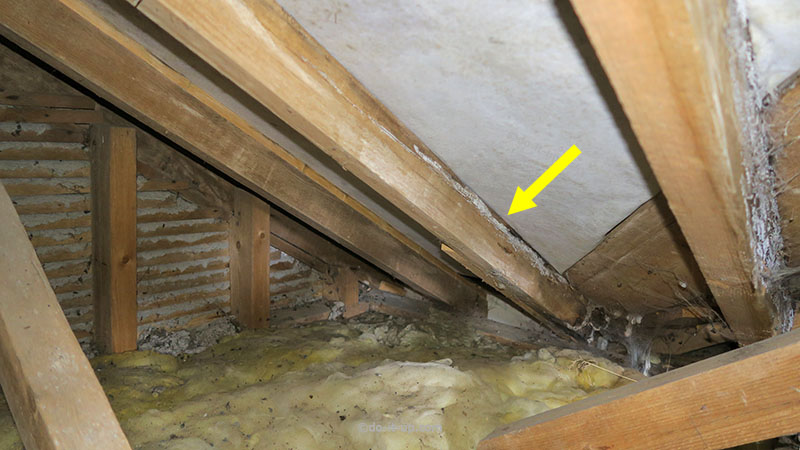
The leak in the image above needs an external repair. Crow’s have chipped away at the concrete used to fix the ridge tiles, allowing water to soak through the roof, when there is prolonged rain.
Water can also track away from the source of the leak, and then fall to the ground. This can give a false idea of where the leak originated.
How to Find the Roof Leak?
It sounds obvious, but finding a roof leak is best done when it’s raining… You can still find a leak on a dry day, (looking for stains and water damage). But, you may not find the source of the leak if the water is tracking across the roof. You usually need to find the highest point where water has entered.
Wind has a horrible habit of making leaks appear where they’ve never been seen before! Plus some leaks only appear when there is sufficient wind speed, a specific wind direction and the correct volume of water. Wind blown rain can produce ‘one off’ leaks too!
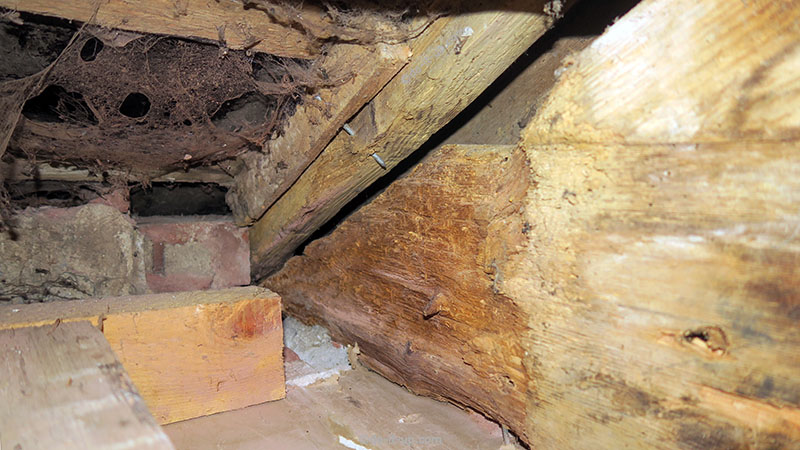
This is where a chimney used to be, (but has since been removed). The lead flashing around the original old chimney must have been defective.
Hopefully you’ll have an easily identifiable leak. Then a repair of the roof can commence. Otherwise it’s a waiting game for a day when the wind speed and rain are blowing in the right direction…
The aim is to trace the leak to its highest point, which would usually indicate that the source is nearby.
What can Cause the Roof Leak?
There can be a number of causes:

Old Age, Wear & Tear:
One of those things, it just happens…
Expansion & Contraction:
Roofs can get very hot and cold over the different seasons. Some materials such as lead flashing can expand and contract a fair amount. If this movement is restricted (sometimes caused by over nailing, or nailing in the wrong place, etc), the material can crack letting in water. This process can happen with other materials on the roof, lead is just a good example.
Impact:
Things can hit your roof. Branches, stones, balls, general windblown debris, (…and hopefully no aeroplane or satellite parts!). All can have an effect, making holes, dislodging or loosening.
Birds:
I like birds, but they can do damage to your roof… Unfortunately my next door neighbor loves to feed crows and seagulls. The worst it got was when there was over 200+ crows and over 45+ seagulls. All at once, in one big food fight.
The issue is… The crows will hang around on our roof, waiting to be fed. They get bored. This is when they start attacking the roof. Their beaks are like little pointed hammers, chipping away looking for bugs! Normally crows aren’t a problem, but whilst they’re waiting to be fed, boredom sets in. You can hear little bits that have broken off, rolling down the roof!
Birds also love to nest, so they may make a hole or two whilst searching for the perfect nesting spot.
Weather:
The wear & tear and expansion & contraction issues are often caused by the weather.
Material Failure:
When built, parts of the roof may not have been installed correctly. Lead flashing may not have been installed correctly, or there has been a component failure. For example, a defect in the lead sheet, a cracked slate, roof tile, etc.
When a Roof Leak Isn’t a Roof Leak:
There are occasions when you get condensation on the inside of a roof. This is when there is a temperature difference between the inside and outside and condensation can form on the underside of the roof.
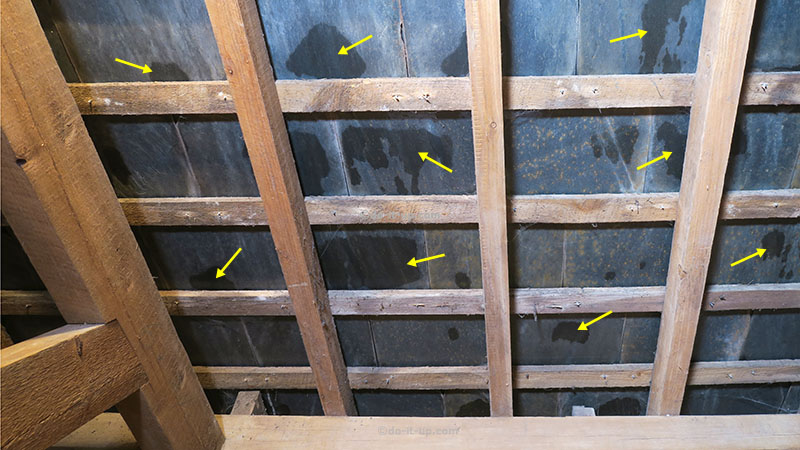
This is nothing to worry about, as long as you have good ventilation in your roof. There must be a good airflow. This will allow the moisture to evaporate and for the roof to quickly dry out.
Underlay:
If you have a roof underlay installed and it is in good condition, then you shouldn’t suffer from any leaks, This is as long as there’s no huge great gaping hole in the roof and the underlay is in good condition.
What is a Roof Underlay for?
Water can sometimes get past the roof covering. This usually occurs when there’s a strong wind (and it’s blowing in the wrong direction). The wind can force the water under the slates or tiles and through any gaps. These type of leaks are usually small and are often random. The underlay directs any of these small leaks away into an external gutter.


Inside Roof Repair – How can I Fix the Roof Leak?
How to Fix a Roof Leak from the Inside… (Opens in a new tab)
Faults should be fixed using the correct method. If a part needs to be replaced, it should be replaced with the correct replacement. However:
- There are times when a temporary repair may be needed.
- Or a different type of repair, is just as good, (and actually may be just as effective and long lasting).
This article describes how to make a repair from the inside of the roof. This should be a much cheaper, easier and safer method…
Topics:

Prerequisites:
- Safe access to the underside of the roof.
- Finding the source of the leak.
- The area where the water has been entering, isn’t huge and not doomed to failure…
Materials:
For this type of repair:
- Polyurethane glue.
Tools:
- Cleaning tools.
- Small pieces of wood, or stiff cardboard.
- Gloves.
- Safety glasses.
- An appropriate dust mask, (protection against glue vapours if needed – Please read the safety data sheet).
Notes:
- Roof coverings may have an under layer (an underlay). These coverings are installed to protect against small leaks (wind blown), and can direct water out of the roof area into a gutter. The underlay can deteriorate over time and can fail. Older houses, don’t often have an underlay fitted, unless the roof has been replaced.
- Polyurethane glue can be used when the surface is wet. This is very handy!
Roof Repair (from the inside):
- Identify where the leak enters through the roof.
- Read the safety instructions on the polyurethane glue container. Wear the appropriate safety equipment.
- Once identified, clean the area to get rid of debris, cobwebs & dust. This will ensure a good bond with the Polyurethane. Note: Polyurethane glue can be used when the surface is wet.
- Dependant on the access available, squeeze the polyurethane into the hole or crack. If this is not possible, use a piece of wood, or stiff cardboard as a makeshift spatula to work the polyurethane into the hole or crack.
- Gravity will want to let the polyurethane fall or run out of the crack. Don’t let it fall out. Keep working it back into the hole.
- Polyurethane expands, (a bit like expanding foam) over time. 15 to 20 minutes later, the polyurethane will start to harden and expand slightly. Note: You can get faster curing Polyurethane glue.
- Eventually, the hole or crack will become blocked and you will no longer have to work the polyurethane into the hole.
- As long as the hole is fully covered, the hole in the roof should be sealed.
The Video:
How to Fix a Roof Leak (From the Inside): This takes you back up to the video…
Notes:
- Do not try to fill every gap. The roof is meant to breathe and be able to expand and contract. Sticking everything together may cause further issues later on. I.e. Only repair the leak.
- I.e. Only repair the leak.
- Don’t use expanding foam. This may expand far more than needed and could cause issues later on.
- If the leak is behind a large beam or covering, you may not be able to gain access to do the repair.
- If a slate or roof tile is missing, this should only be used as a temporary repair. Replacing the slate or roof tile is probably a better long term repair.
Ordering Tools & Materials:
The following table gives examples of the glue, gloves and vapour mask you can buy to fix your roof. If you’re not sure what you need, sometime it’s worth having a look? The list below may give you an idea of what’s what’s available, what to look for and how much it costs…
Ordering Materials – Examples of What You Can Buy:
| Leaking Roof Materials (How Much Do They Cost?) |
|||
|---|---|---|---|
| Location | Items | ||
 UK UK |
Polyurethane Glue | Gloves | Vapour (Vapor) Mask |
 USA USA |
Polyurethane Glue | Gloves | Vapour (Vapor) Mask |
 AUS AUS |
Polyurethane Glue | Gloves | Vapour (Vapor) Mask |
 CAN CAN |
Polyurethane Glue | Gloves | Vapour (Vapor) Mask |
 IRL IRL |
Polyurethane Glue | Gloves | Vapour (Vapor) Mask |
Thank you for your support.
Image Gallery:
– click or tap the image to view full size –
